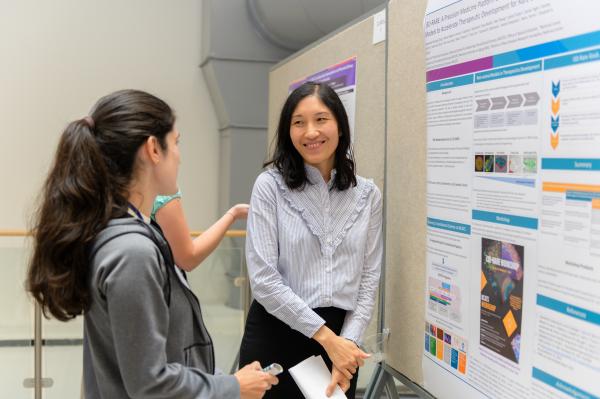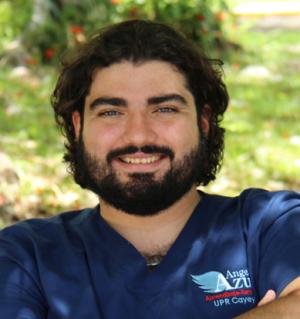Hunting Down Good Science
Discovery on Display at the NIH Research Festival Poster Sessions
BY CODY CONRAD (NIAID) AND DARWING PADILLA ROLON (NIAID)
The air was astir with the rumbling of fresh findings emanating from the postpandemic return of the NIH Research Festival on Monday, September 18. Over the next two days, nearly 400 posters capturing the breadth of NIH intramural research lined the Clinical Center FAES terrace, with an additional 40 showcased in a Wednesday virtual-only session.

CREDIT: MARLEEN VAN DEN NESTE, NIH
David Adzrago of NIMHD explained his poster which explored associations between mental health and physical activity.
Beaming scientists, both novice and tenured, stood poised at their stations, eager to present. A curious multitude of students, fellows, staff scientists, principal investigators, and more grazed about to network and to contemplate this latest crop of discoveries and ideas on display.
Among the presenters was Postdoctoral Fellow Verity Ford from the Clinical Center’s Critical Care Medicine Department, who studies the effects of sepsis on the heart and focuses her passion for research to answer critical care medicine’s most burning questions.
Ford’s work in Senior Investigator Charles Natanson’s lab demonstrated that the end-diastolic volume of hearts in surviving animals that are experiencing septic shock is substantially higher than in nonsurvivors. The damaged heart muscle becomes unable to pump blood properly, and this problem can lead to heart failure, highlighting the detrimental effect that sepsis can have.
Unexpectedly, the dry mass of the heart decreased markedly during sepsis, leading Ford to posit that heart endothelial cells, its intracellular contents, or the extracellular matrix may be damaged and being removed or sloughing off during disease. Her poster showed how magnetic-resonance imaging can be used to calculate decreasing heart mass in living organisms with sepsis.
Ford said that Natanson is equally intrigued by the new findings, and the scientists are ready to delve deeper into the data to uncover more about sepsis’ effect on the heart as a way to understand the multi-organ failure that is the leading cause of death from sepsis.

CREDIT: MARLEEN VAN DEN NESTE, NIH
Darawalee Zong (shown on right) from NCATS presented her work on a precision medicine platform to accelerate therapeutic development for rare diseases.
Further down the maze of posters, postdoctoral fellow Yi Wei Lim at the National Center for Advancing Translational Sciences (NCATS) was ecstatic about measuring the immunological success in her tissue samples. Her enthusiasm about the resources available at NIH and her work shone through as she discussed the finer points of manufacturing full-thickness, immunocompetent skin.
Lim and her supervisor Marc Ferrer, Director of NCATS’ 3D Tissue Bioprinting Laboratory, delight in defying the limits of what is possible in a laboratory setting where they produce, validate, and use 3D biofabricated tissues for disease modeling and drug discovery. She described the creation of a high-throughput system to evaluate the disease-modeling capabilities and immunological features of their biofabricated skin.
Her team found that in the presence of bacterial and viral stimuli, immune markers and components were highly upregulated and shown to be macrophage-dependent, demonstrating that the model behaved immunologically like real skin. And according to Lim, some markers of healing progressed faster than expected. “I was expecting pro-inflammatory macrophages to become anti-inflammatory macrophages later in the skin culture [immune response] but was surprised that the switch was rapid—within 72 hours,” she said.
The investigators hope that their model will allow for high-throughput pharmacological, wound healing, and infectious disease studies involving epithelial tissue.
Ryo Sato’s Fellows Award for Research Excellence-winning poster showed how class III beta-tubulin may be a potential biomarker for idiopathic pulmonary fibrosis, a condition in which the lungs become scarred, affecting breathing. Sato is a Visiting Fellow at Senior Investigator Yosuke Mukoyama’s lab at the National Heart, Lung, and Blood Institute. Through high-resolution imaging they have shown how pericytes, specialized cells lining the walls of capillaries, induce the tubulin expression in response to inflammatory signals and modulate the detrimental effects that fibrotic macrophages and fibroblasts have on pulmonary fibrosis. According to Mukoyama, Sato’s unexpected results have proven to be a significant discovery.
The team seeks to understand the neurovascular mechanisms behind that pathway, which could revolutionize the way we diagnose and treat pulmonary fibrosis.
“Mentoring fellows is among the most rewarding part about my work,” said Mukoyama. He is excited to see what the future may hold for early-career investigators like Sato, and he enthusiastically supports his fellows’ drive to start their own labs to expand on the clinical implications of their discoveries.
Jennifer Zink, a Cancer Prevention Fellow in the Behavioral Research Program at the National Cancer Institute, presented her work that analyzed screen-time data of 10-year-old youth. She used data from NIMH databases to evaluate whether different kinds of screen time—gaming, streaming, or socializing—were related to Body-Mass Index while also accounting for other factors such as physical activity and sleep. She found that boys with more socializing time had higher BMI.
To further probe that association, Zink used the traditional isotemporal substitution method, which models theoretical behavioral replacement effects. For example, if 30 minutes of gaming was replaced with 30 minutes of socializing, it had a theoretical beneficial effect on BMI. “I do think that there is some sort of interpersonal or social component that is contributing to these different associations [that needs] to be further investigated,” Zink said.
While in graduate school Zink worked on similar research in which she studied how screen time may have a detrimental effect on mental health. She hopes to continue this kind of multidisciplinary approach to better understand the relationships between sociobehavioral factors and health.

CREDIT: MARLEEN VAN DEN NESTE, NIH
A research team from the Clinical Center's Translational Biobehavioral and Health Disparities Branch presented their work on unravelling gut-brain communication mechanisms in patients with alcohol use disorder. Shown left to right: Nicole Farmer, Jennifer Barb, Rebecca Metellus, Stephanie Wildridge, Katherine Maki, Karleigh Fraser, Scott Reid, Ayaan Ahmed.
For the first time at the NIH Research Festivals, the organizers arranged a virtual-only session particularly for NIH colleagues not on the Bethesda campus, such as those in North Carolina at the National Institute of Environmental Health Sciences (NIEHS).
Among the dozens presenting in this new format was Independent Resarch Scholar Mandy Goldberg, who presented research done as a postdoctoral fellow in NIEHS’ Epidemiology Branch, led by Dale Sandler. Her virtual booth was packed with visitors eager to hear about personal-care product use during puberty and the incident breast cancer later in life. The unpublished work may be the subject of a future Catalyst article.
Anisha Singh, a postdoc in the NIEHS Division of Translational Toxicology, Integrative Health Assessments Branch led by Andrew Rooney, presented her group's early work in developing a systematic evidence map of autism research. This interactive database will be called aWARE, short for A Web-based tool for Autism Research and the Environment. Their objective is to identify and characterize published literature relevant to environmental exposures associated with autism spectrum disorder and summarize or map the research gaps and knowledge clusters—yet another project to follow.
Ian Trees, a postdoc in the laboratory of Edwina Yeung in the Epidemiology Branch at the Eunice Kennedy Shriver National Institute of Child Health and Human Development (NICHD), reported on a nugget from the Upstate KIDS Study, a collaboration among the New York State Department of Health, the University at Albany (State University of New York), and NICHD. His team found evidence that prenatal exposure to particulate matter may affect birthweight depending on other pollutants and specific windows of exposure.
Collectively, the posters revealed a fantastic diversity of research thriving in the NIH IRP, with the science community not afraid to push the limits, think outside the box, and share ideas. To see poster abstracts, refer to https://researchfestival.nih.gov/2023/poster-sessions-presentations.

Cody Conrad is a postbaccalaureate trainee at the Laboratory of Viral Diseases (NIAID) where he studies the mechanisms of papillomavirus infection. In his spare time he keeps busy with music composition, chess, and pickleball.

Darwing Padilla Rolon is a post-baccalaureate Intramural NIAID Research Opportunities Fellow and is studying neuroimmune interactions in neuroimmunological diseases by developing cerebral organoids. Outside of the lab, he enjoys playing volleyball and traveling to see his family in Puerto Rico.
This page was last updated on Tuesday, November 7, 2023
